How to Use McKinsey's 7-S Framework: A Complete Guide (Plus FREE Template)
How to Use McKinsey's 7-S Framework: A Complete Guide (Plus FREE PowerPoint Template) Introduction, Definition, Key Questions, and FREE Template download.
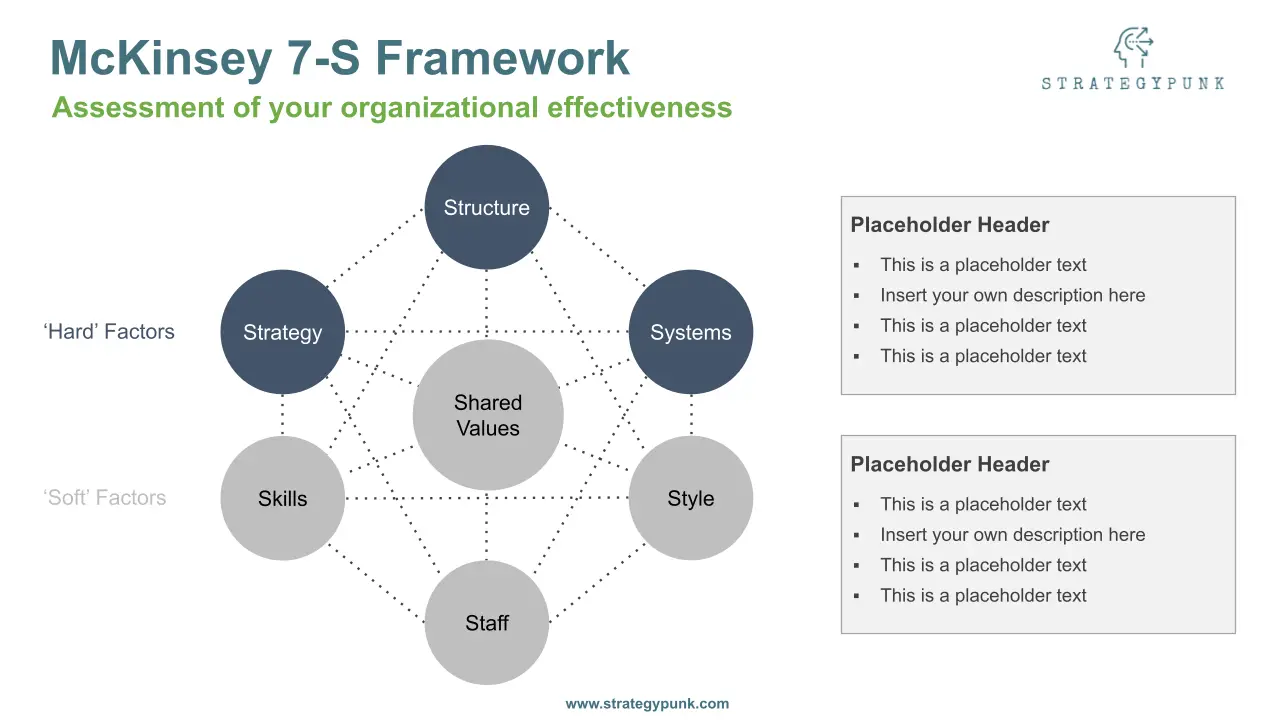
Introduction
The McKinsey 7-S framework is a management tool developed by McKinsey & Company in the 1980s to help organizations align their strategy, structure, systems, shared values, style, staff, and skills to achieve their goals.
The framework is based on the idea that all of these elements must be aligned and harmonious for a business to succeed. It is often used to help organizations identify areas for improvement and achieve desired changes.
The 7-S Framework is built around seven key elements: strategy, structure, systems, style, staff, skills, and shared values.
In this article, we’ll explore these elements and how they can be used to create a more effective and efficient organization.
What Is the McKinsey 7S Model?
The McKinsey 7-S Model is a framework for analyzing an organization's effectiveness.
It divides the organization into seven elements: Strategy, Structure, Systems, Style, Staff, Skills, and Shared values. The model suggests that these elements must be aligned and mutually reinforcing for the organization to be successful.
The model can diagnose a company's current state and identify areas that need improvement to achieve organizational goals. The McKinsey 7-S Model is a valuable tool for organizations of all sizes.
The Elements of the 7S Model
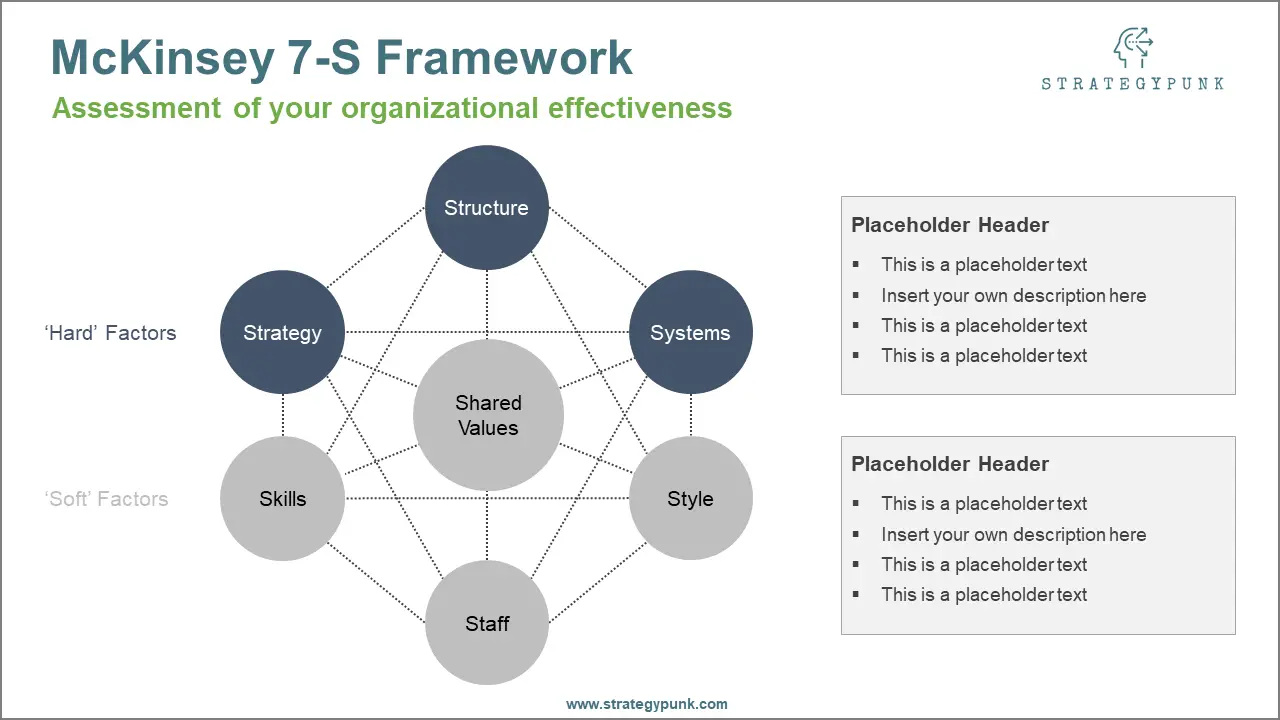
The seven key elements of the McKinsey 7S Model are as follows:
Strategy
The “why” of the business is a statement of direction, mission, and focus that drives how people inside the organization operate.
The plan of action the organization takes to achieve its goals and objectives.
Structure
The physical and organizational aspects of the business, including people, skills, knowledge, and culture.
The way the organization is physically and formally divided into departments, units, and positions.
Systems
The procedures, policies, structures, and systems govern, organize, and guide people's work.
The processes, procedures, and routines that the organization uses to get things done.
Style
How people work together, the culture, language, and the “tone at the top” of the organization
Staff
The current talent in the organization includes future leaders, knowledge workers, and suppliers.
The people who work for the organization, including their experience, education, and qualifications.
Skills
The development of people and the organization to achieve its vision and goals.
The capabilities and competencies of the organization's members.
Shared values
The guiding principles and core values are essential to creating a strong culture.
The core beliefs and principles that the organization's members share.
The model suggests that these elements must be aligned and mutually reinforcing for the organization to be successful.
The model can diagnose a company's current state and identify areas that need improvement to achieve organizational goals.
What are the soft and hard elements in the 7S Framework?
The 7-S McKinsey Framework differentiates between hard and soft factors:
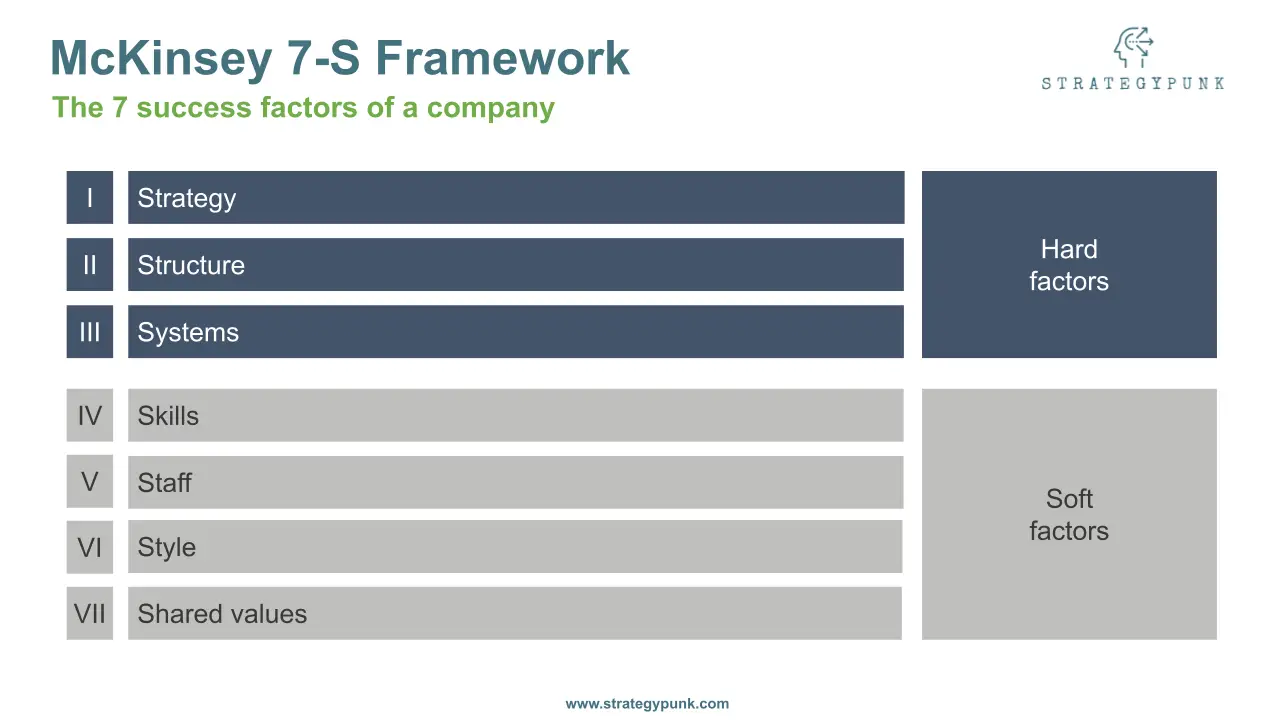
Hard factors
Strategy:
Target system and all measures to achieve a sustainable competitive advantage and successfully compete in the market.
Structure:
The way the business is organized. In short, the organizational chart of the company.
Systems:
Processes and procedures of the company, including reporting system and IT infrastructure.
Soft factors
Skills:
Abilities and core competencies of the company’s employees.
Staff:
Type and number of employees of the company. Measures to recruit, train, reward, and motivate the team.
Style:
The management style of the company. Culture, how people interact with each other, and the environment
Shared values (Core of the McK 7-S-Model):
Values, norms, and standards that apply within the company.
McKinsey 7-S framework for successful business change
The McKinsey 7-S Framework is a valuable tool for organizations of all sizes. It can be used to assess an organization's current state and to develop a plan for achieving the desired shape.
This can be done by answering the following questions:
- What is our current state?
- Where do we want to be?
- What do we need to do to get there?
If you've answered these questions, you've implemented the McKinsey 7-S Framework. The model can also be used to assess an organization's effectiveness.
How to implement the McKinsey 7-S Model
Before looking at how to use the McKinsey 7-S Model, you need to assess your organization’s current state. Identifying your organization’s current state will help you figure out what to improve, and it will also help you prioritize your improvements.
Your organization’s current state can be divided into structure, strategy, and performance. These dimensions can help you determine its current state.
Once you’ve assessed your organization’s current state, you can use the McKinsey 7-S Model.
To start working on the 7-S key factors of improvement - Strategy, Structure, Systems, Style, Staff, Skills, and Shared values—you’ll want to start small in each area, focusing on specific steps to address the challenges. This will help keep your organization focused on the critical areas of improvement and help you get results quickly.
To implement a results-oriented strategy, you’ll want to ensure that your people understand the outcomes of the 7-S procedure, find ways to measure the results, and how to turn the results into action.
What is the McKinsey 7S framework in simple words?
The McKinsey 7S framework is a management tool developed by McKinsey & Company to analyze and improve organizational effectiveness.
Simply put, it's a way to examine an organization from seven different perspectives to ensure that all parts are aligned and working together towards a common goal.
These seven elements, represented by the letter 'S', are:
- Strategy: An organization's plan to win in its market.
- Structure: How the organization is arranged, including its hierarchy and departments.
- Systems: The organization's processes and tools to accomplish things.
- Shared Values: The organization's core beliefs and cultural norms.
- Skills: The capabilities and competencies present within the organization.
- Staff: The employees and their roles within the organization.
- Style: The leadership approach and the way the organization operates.
The key idea is that all these elements are interconnected, and for an organization to perform well, they need to be aligned and in harmony.
How to use the McKinsey 7-S Model in change management?
Using the McKinsey 7S Model in change management involves assessing and aligning an organization's seven interrelated elements to ensure that changes are effectively implemented and sustained.
Here's a step-by-step guide on how to apply the framework in the context of change management:
Diagnose the Current State:
- Strategy: Understand the current strategic objectives and how the proposed change might impact them.
- Structure: Examine the existing organizational structure to identify any barriers or facilitators to change.
- Systems: Review current processes, tools, and systems to determine if they support or hinder the change.
- Shared Values: Gauge the prevailing organizational culture and values to see if they align with the change.
- Skills: Identify the current skill sets and capabilities and determine if they match the change requirements.
- Staff: Assess the current workforce regarding their readiness, concerns, and potential resistance to change.
- Style: Understand the leadership and management styles and how they might influence the change process.
Envision the Desired Future State:
- Define the ideal post-change scenario for each of the 7S elements. This provides a clear vision for the organization's goals.
Identify Gaps:
- Compare the current state with the desired future state for each of the 7S elements. This will highlight areas that need attention and adjustment.
Develop Action Plans:
- Based on the identified gaps, create specific action plans to address each element. For instance, if the current skills don't align with the change, plan for training or hiring.
Implement the Change:
- Execute the action plans, ensuring that changes in one element are consistent with changes in others. For example, if the strategy changes, ensure that the systems and structure support this new direction.
Monitor and Adjust:
- Continuously monitor the progress of the change initiative using the 7S framework as a reference. Based on feedback and changing circumstances, make necessary adjustments.
Reinforce Shared Values:
- Throughout the change process, emphasize and reinforce the organization's core values to ensure alignment and cohesion. This helps gain buy-in and reduce resistance.
Engage Leadership:
- Ensure that leaders at all levels are champions of the change. Their style and approach can significantly influence the success of the change initiative.
By systematically addressing each of the 7S elements in the context of change management, organizations can ensure a holistic and integrated approach to change, increasing the likelihood of its success and sustainability.
Summing Up
Now that you know the framework, it's time to implement it. The McKinsey 7-S Framework can help organizations develop a vision, create a vision statement, prioritize activities, and make strategic choices.
Once you understand the framework, you can use it to guide your organization's decision-making process. It will help you integrate business strategy with organizational structure, systems, staffing, and skills.
The McKinsey 7-S Framework helps organizations define their vision for the following years and set a course for success in achieving it. The framework allows organizations to better assess the future and make wise choices.
Additional Resources
Additional resources and tools to develop and implement your strategy:
McKinsey's 3 Horizons Framework
BCG Matrix: Introduction and Excel Template
Michael E. Porter's Five Forces
McKinsey 7-s Framework Template
Please subscribe and sign in to download all the published templates on StrategyPunk: FREE and fully editable.
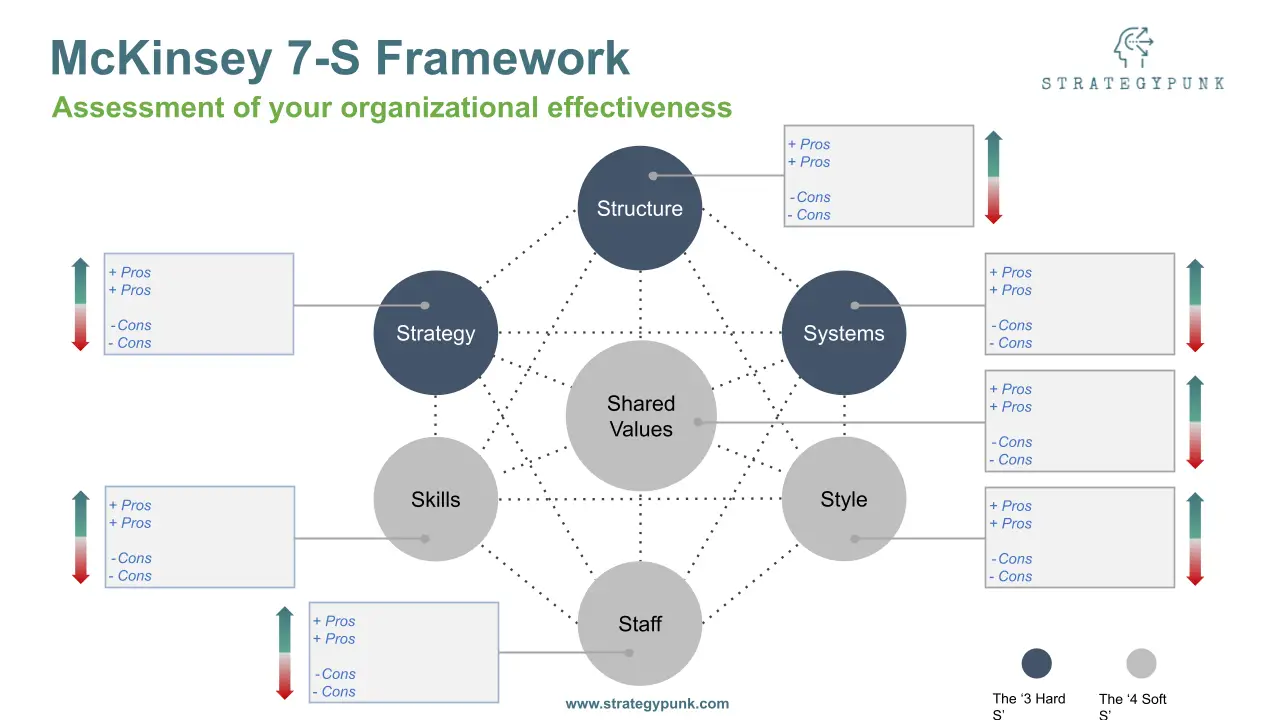
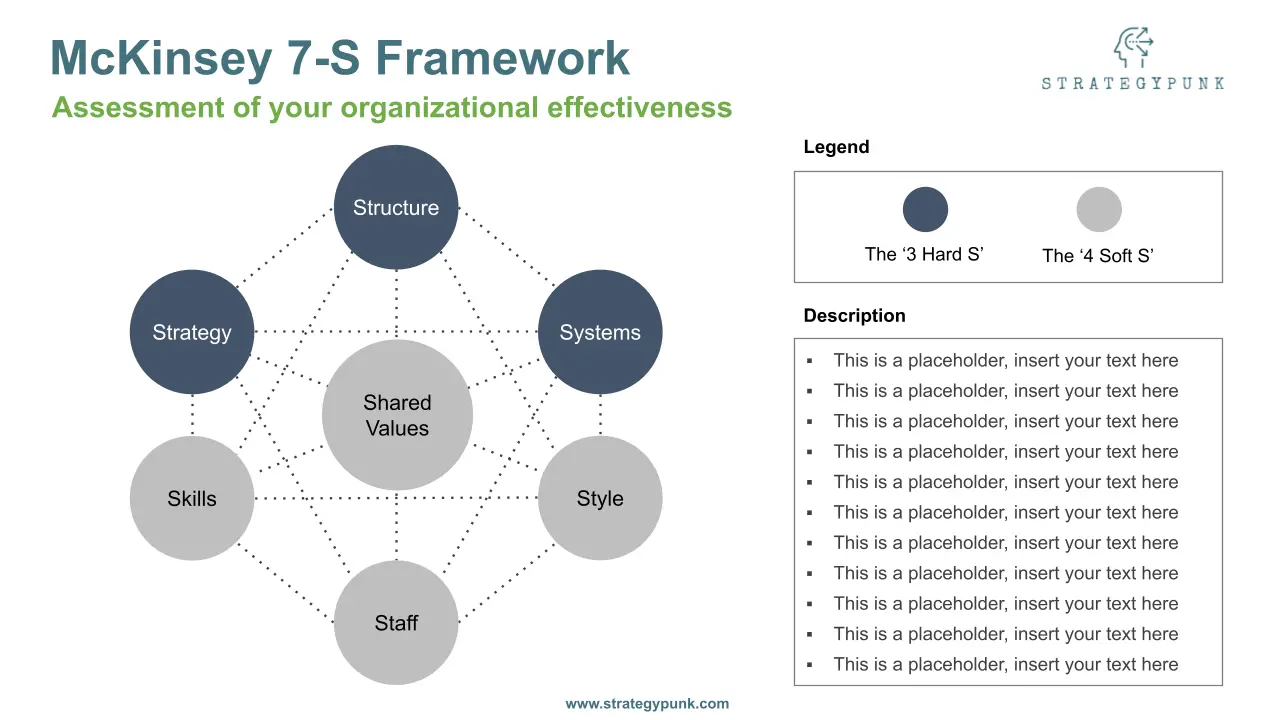
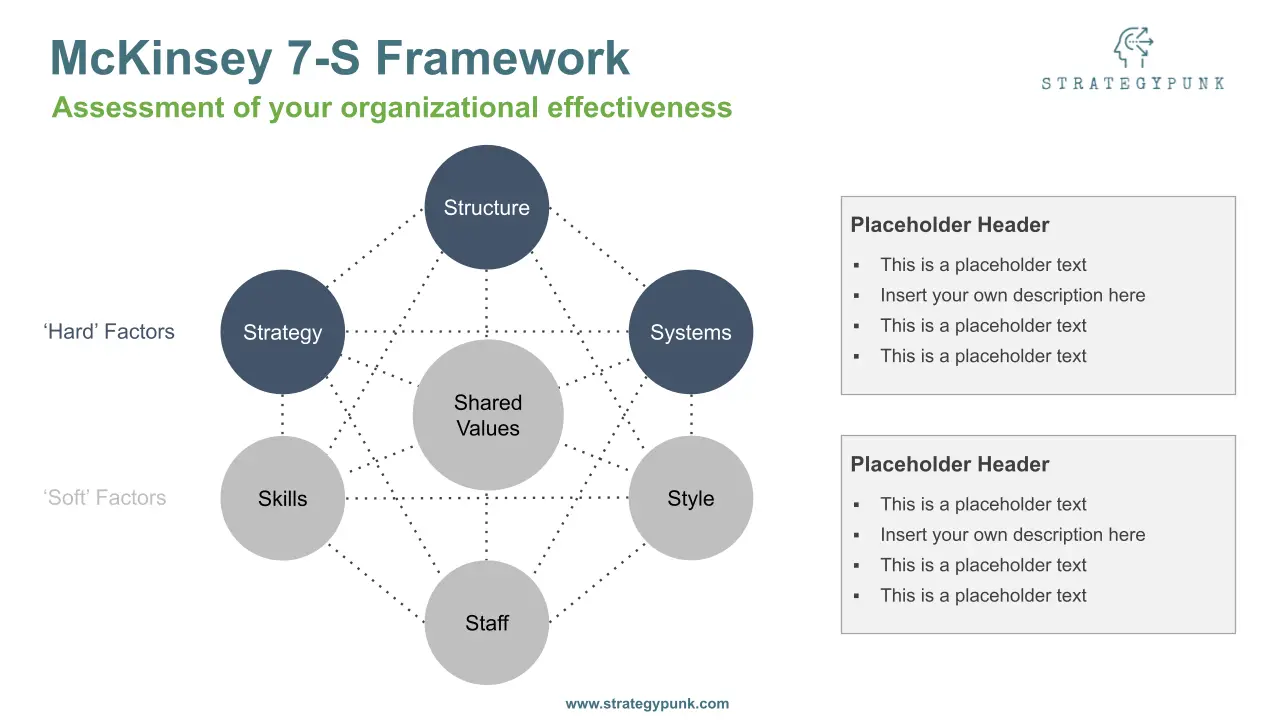
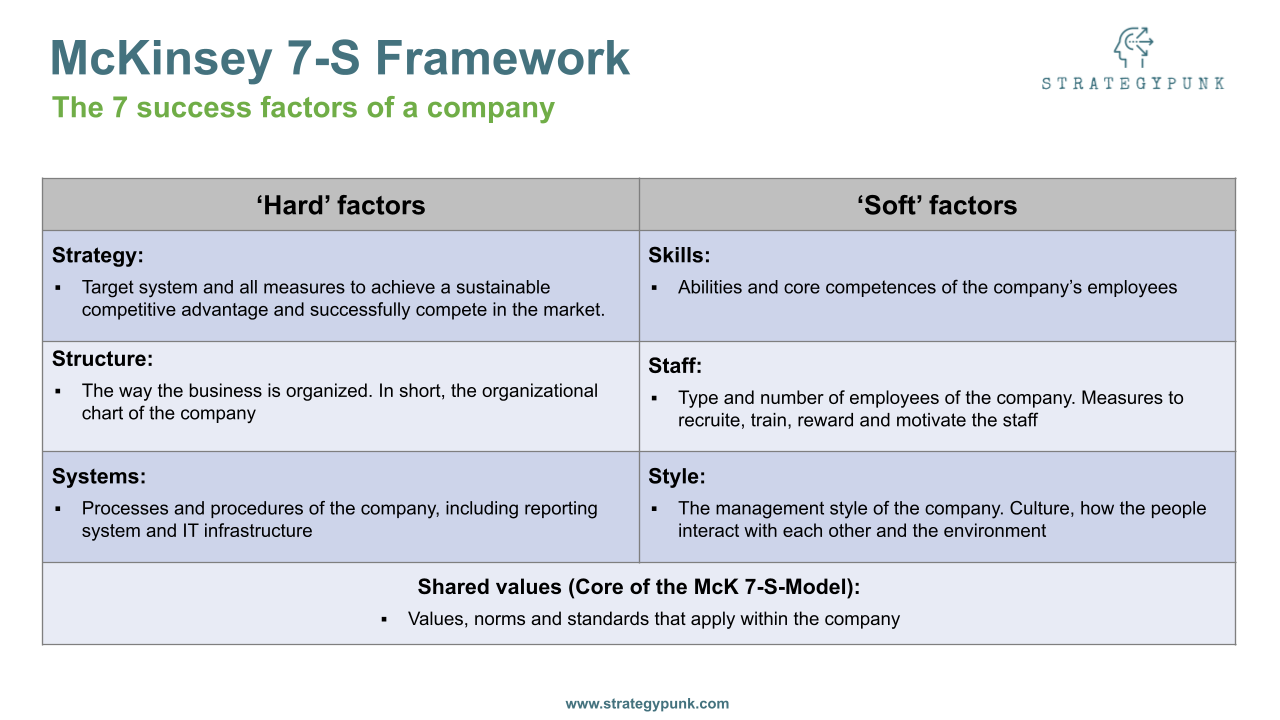
McKinsey 7-s Framework Template





